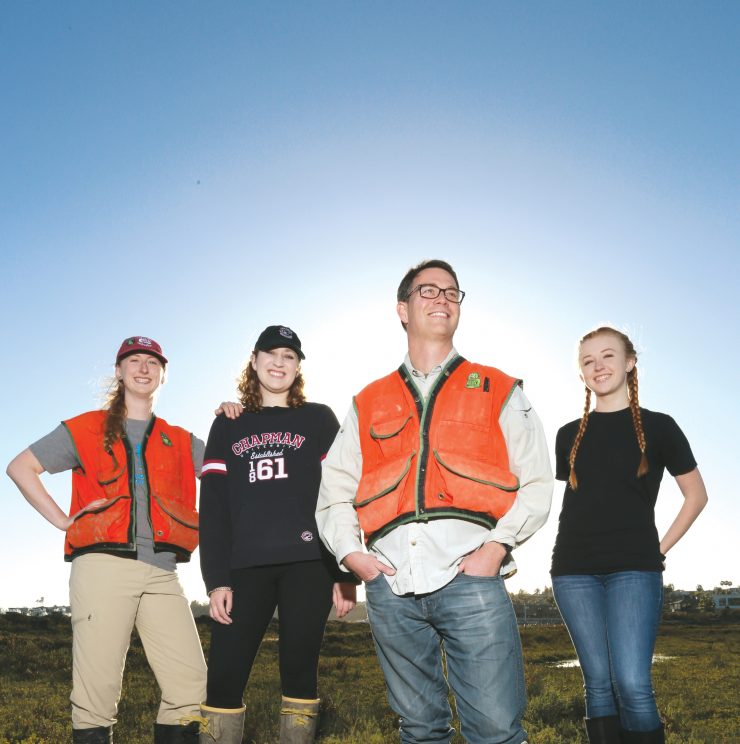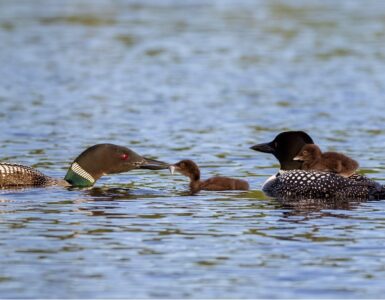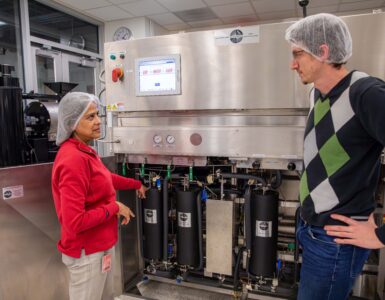AMID THE SCENT of spruce trees in northern Minnesota, an odd sight rises from the peatland bog. Ten silolike enclosures nearly 30 feet tall and 40 feet across dot a small area of the 2,800-acre Marcell Experimental Forest, a part of the U.S. Department of Agriculture’s Experimental Forest network. The tops of the octagonal chambers are open to the rain and snow, but inside the temperatures and carbon dioxide levels are carefully controlled. Each chamber is designed to simulate a different climate change scenario.
“Welcome to a warmer future,” declares a sign at the entrance to an enclosure that is heated to 9 degrees Celsius warmer than the outside temperature, representing a dramatic change in climate. Inside, spring comes early and autumn arrives late.
Chapman University Associate Professor Jason Keller, Ph.D., and his student researchers journey to this outpost in the southernmost part of North America’s great boreal forest about four times each summer. Together, they gather data and collect samples they ship back to their campus laboratory in the sort of coolers you would expect to hold cold drinks.
Instead, the coolers could hold clues to the future of the planet.
The Chapman researchers are part of a project known as SPRUCE – an acronym for Spruce and Peatland Responses Under Changing Environments – that is funded by the U.S. Department of Energy (DOE) and operated by Oak Ridge National Laboratory. In 2015, Keller was awarded a three-year, $1.5 million DOE grant as principal investigator on a SPRUCE project in collaboration with the University of Oregon and Purdue University. Chapman also was part of a $1 million DOE grant for peatland research in 2012, securing about $400,000 of that amount.
The interest in a remote peatland forest 200 miles north of Minneapolis might seem puzzling at first. Yet peat – the slowly decomposing organic matter that for centuries has been dug up, dried and burned as fuel in parts of northern Europe – is key for understanding climate change. Since the retreat of the glaciers, northern peatlands have acted as carbon sinks – pulling carbon dioxide from the atmosphere and storing it belowground in their soils. Though peatlands cover only about 3 percent of below ground Earth’s surface, they store about a third of the planet’s soil carbon.
“What motivates our work at SPRUCE is the possibility that soil carbon that has been stored in peatlands may suddenly return to the atmosphere as the greenhouse gas methane. That process would have global implications for Earth’s climate,” Keller said.
“We don’t know if that’s going to happen or not. That’s the point of doing the experiments. We need to figure this out. Maybe the soil carbon stays belowground and is not responsive to warming at all – which would be less dramatic, and have a smaller impact on the global climate.”
Variables and Controls
Two of the 10 enclosures at the SPRUCE site remain unheated, as controls. Two others are heated to 2.25 degrees Celsius above the temperature outside, two are plus-4.5 degrees, two are plus-6.75 degrees and two are 9 degrees above the outdoor temperature that fluctuates with the seasons.
In addition to warming the air in eight of the 10 enclosures, researchers also designed a way to warm the soil in those chambers to about 10 feet below the ground via vertical heating rods. Five of the enclosures – one at each temperature, including one unheated chamber – also receive an elevated atmospheric carbon dioxide treatment, adding another variable.
The combination of temperature and elevated carbon dioxide treatments allows Keller and other researchers to explore 10 possible climate scenarios and see how the bog will respond. “By considering this wide range of possible futures, we are able to inform mathematical models that could better describe the connections between peatlands and the global climate,” Keller said.
When Keller and his students – mostly undergraduates or recent graduates continuing their research – visit SPRUCE, they collect water and soil samples, some of them removed from up to 10 feet below the surface with a device known as a Russian corer.
“We shove it down, twist it, pull it back up, open it up and we are holding soil that is thousands of years old. It is pretty cool,” Keller said.
Those soil samples are mostly what was once sphagnum moss – similar to the peat moss you might buy for your home gardening projects – but in progressive states of decay. Cold temperatures and wet conditions that limit the availability of oxygen slow the decomposition of the moss and other plants, allowing the carbon-rich soil to persist for centuries beneath the surface.
“Sixty times more carbon than we emit every year from fossil fuel burning worldwide is stored in peat, and it’s been sort of slowly accumulating there over thousands of years,” Keller said.
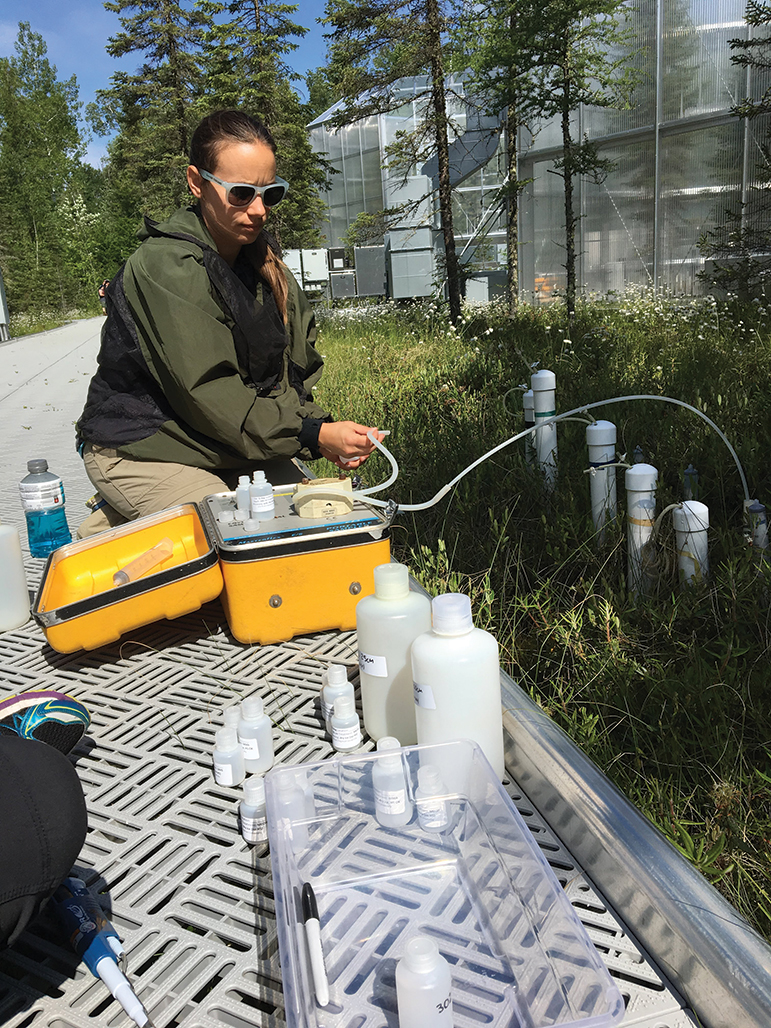
Lessons of Spruce
Back on the Chapman campus in the Keller laboratory, which moved in September from Hashinger Science Center to an expansive, state-of-the-art facility on the second floor of the $130 million Keck Center for Science and Engineering, Keller and his students study the soil and water samples. They use equipment such as a gas chromatograph to measure carbon dioxide and methane concentrations, and often work with samples in an anaerobic glove box, a space without oxygen.
The results of the SPRUCE research so far have been interesting.
Keller was among the co-authors of 2016 article in the journal “Nature Communications” describing the initial finding that while surface soils produced more methane in response to deep soil warming at SPRUCE, the vast carbon stores in deeper soils were less responsive to the warming treatments. The second lead author on the paper, Anya Hopple, a post- doctoral researcher from the University of Oregon, joined Keller’s laboratory this fall.
The findings would suggest that a slow incremental rise in temperature might not have devastating effects on the release of the carbon stored in peatlands, as some fear. At least not initially. Much of Keller’s ongoing work explores whether the deep soil carbon remains stable as the heating treatments continue.
“It’s all about the feedbacks,” Keller said. “Peatlands are a perfectly normal part of the climate system and have been since they existed. But if our initial change of the climate system causes these peatlands or other wetlands to act differently, that has the potential to create globally-significant feedbacks. If wetlands start releasing more methane, that could accelerate climate change.”
Among other work Chapman students pursue at the Minnesota site is studying humic substance reduction, or the way microbes breathe organic compounds instead of oxygen. Jessica Rush ’18, a recent Chapman graduate who is working as Keller’s laboratory manager this year, said she entered college as a pre-med student but changed her mind.
“I joined Dr. Keller’s lab my sophomore year and took physiology my junior year. I found myself loving research more and more,” she said.
Emily Hanna ’18, now pursuing a graduate degree at UC Irvine in public health with an environmental health emphasis, studied a novel process called methylotrophic methanogenesis in the Minnesota peatlands.
“I think a lot of students gravitate toward global change questions or sustainability questions,” Keller said. “The world is changing, and for our students the world is going to look different when they’re my age than it does now.”
“This is going to be a big issue for them. For many of them, it already is a big issue. They’re already working on it.”
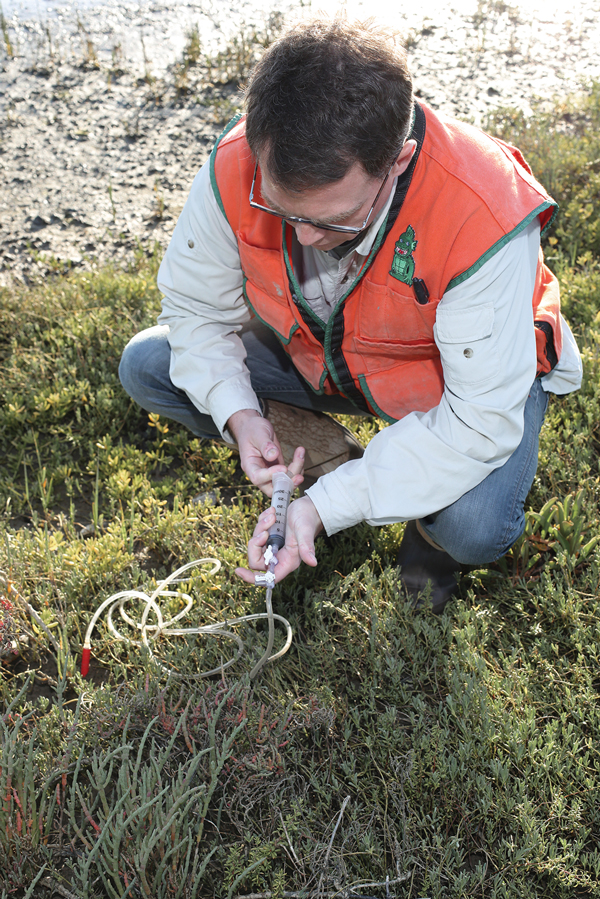
global environment allows researchers to consider a “wide range of possible futures,” Professor Jason Keller says.
Awash in Opportunities
At UC Berkeley, Chapman University graduate Tyler Anthony ’14 is a Ph.D. candidate studying greenhouse gas emissions in corn and alfalfa fields in the Sacramento-San Joaquin Delta. He focuses on the impacts of soil type as a driver of climate change response in agriculture.
At the University of Michigan, Chapman graduate Jennifer Bowen ’15 is a Ph.D. candidate studying how the chemistry of natural organic molecules in streams and other freshwaters controls the release of carbon dioxide, a greenhouse gas, into the atmosphere.
“I’m really interested in how the global carbon cycle is changing with climate change,” said Bowen, who earned dual degrees in chemistry and environmental science and policy at Chapman.
Anthony and Bowen have more in common than literally getting their hands dirty pursuing important questions in environmental science. They both are building on extensive opportunities to conduct research as undergraduates at Chapman.
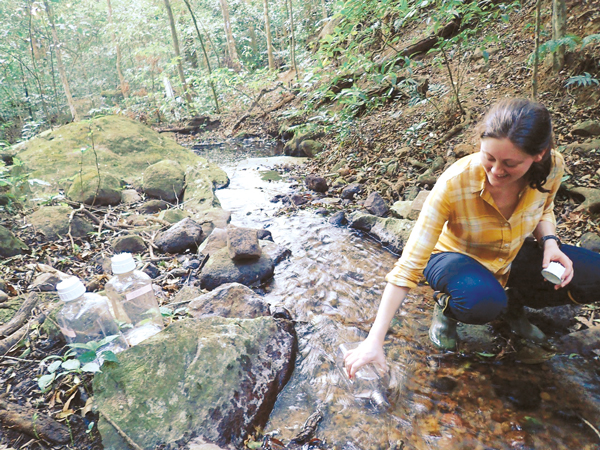
own questions and test them.”
Jennifer Bowen ’15
Bowen began working in the salt marshes of coastal Orange County after her first year at Chapman, initially following instructions and learning how to operate instruments. She later carried out her own study at the salt marsh and also conducted laboratory research on samples from the Minnesota peatland studies led by Jason Keller, Ph.D., an associate professor in the Schmid College of Science and Technology. In addition, Bowen co-authored multiple papers with Warren de Bruyn, Ph.D., a professor of chemistry at Chapman.
“By my third and fourth year, I was carrying out independent research,” she said. “I think some of the major differences between the undergraduate research experience at Chapman and larger universities is the fact that at Chapman you get to develop your own questions and test them. At Chapman, you have the opportunity to do research that teaches you how to be a real scientist.”
Anthony, who earned a degree in environmental science and policy at Chapman, recently was awarded a $150,000 Delta Science Fellowship for early-career scientists for his work related to greenhouse gas emissions, nutrient cycling and ecosystem health in the San Francisco Bay-Delta region.
“This area is a water source for 20 million people, but it’s also very highly productive agriculturally,” Anthony said. “It was wetlands 150 years ago, 200 years ago, but they drained it because it’s really good soil for crops.” His work could help farmers make decisions about which crops to grow or whether to restore their land to wetlands and sell the carbon offset credits in the cap-and-trade market.
Before evolving into a wetland biogeochemist, Anthony conducted research as a Chapman undergraduate in the Kim Environmental Geochemistry Laboratory under Professor Christopher Kim, Ph.D., and worked as lab manager for a year after graduating before beginning his postgraduate work at Berkeley. He also studied wetland soil carbon storage with Keller.
The research opportunities and close engagement with professors at Chapman were deciding factors in his final choice among three colleges, Anthony said, particularly after his cellphone rang just as he was driving to visit another school as a high school senior. The call was from Kim.
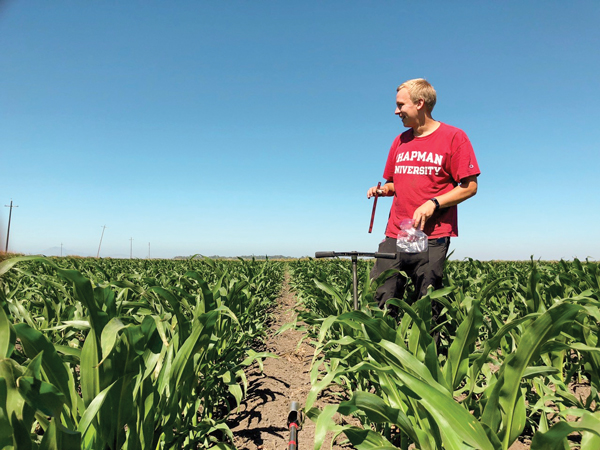
Tyler Anthony ’14,
on undergrad research at Chapman
“He said, ‘You can have all these opportunities to know your professors one- on-one in small classes and help shape your curriculum,’” Anthony said. “That’s what sold me. And that’s actually the experience I got.”
Professors like Keller continue to deliver such experiences.
“What makes Chapman unique is not that we’re doing really good wetland biogeochemistry,” said Keller, who led students on multiple trips to Minnesota last summer. “I think what makes Chapman unique is that we’re doing really good wetland biogeochemistry with undergraduates.”
